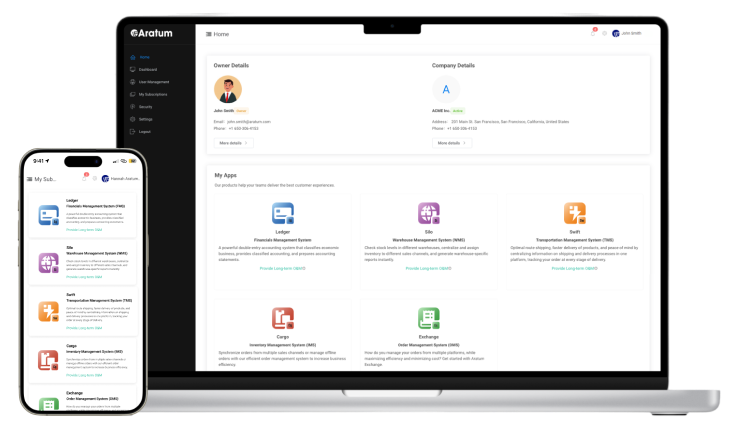Inventory is like the water level in a river. When the water level lowers, boulders or problems stick out.
Having a good grip on your inventory corresponds to a steady financial flow in your business. Advanced technologies like AI and the cloud give you absolute control over your inventory.
Aratum’s Technological Solutions gives unprecedented inventory power for an efficient, unwavering, and smooth-flowing supply chain.
Inventory Optimization
Demand Forecasting
Safety Stock Management
Lead Time Management
Supplier Collaboration
ABC Analysis
Continuous Improvement
Cross-Docking
Just-In-Time (JIT) Inventory
Efficiently managing inventory levels across the supply chain to minimize holding costs while ensuring product availability.

Using historical data, market trends, and other factors to accurately predict future demand, optimize inventory levels, and avoid stockouts or overstock situations.

Maintaining a buffer stock to account for variability in demand, lead times, and supply chain disruptions ensures continuity of supply even in unpredictable circumstances.

Monitoring and reducing the time it takes for goods to move through the supply chain from suppliers to customers reduces the need for excess inventory.

Utilizing technology such as RFID, barcoding, or inventory management systems to track inventory movements in real-time provides visibility across the supply chain.

Classifying inventory items into categories based on value and prioritizing management efforts accordingly. This helps focus resources on high-value items while optimizing inventory levels for low-value items.

Implementing continuous improvement processes such as Lean or Six Sigma to identify inefficiencies and waste in inventory management processes, leading to cost reductions and improved efficiency.

Transferring incoming goods directly from inbound to outbound transportation minimizes inventory holding time, reduces storage costs, and improves responsiveness to customer demand.

Adopting JIT principles to minimize inventory levels by receiving goods from suppliers only when needed in production or for fulfilling customer orders, reducing holding costs, and improving cash flow.

Efficient management of medical supplies and equipment to ensure availability for patient care while minimizing wastage and stockouts.
Optimizing product inventory levels to meet customer demand, reduce stockouts, and maximize sales while minimizing holding costs and markdowns.
Maintaining optimal inventory levels of drugs and vaccines to meet patient demand, comply with regulatory requirements, and minimize expiration losses.
Balancing inventory levels across multiple warehouses to efficiently fulfill online orders, minimize shipping times, and improve customer satisfaction.
Managing inventory of vehicles, spare parts, and fuel to ensure smooth operations, minimize downtime, and optimize fleet utilization.
Ensuring proper storage and transportation of temperature-sensitive goods such as perishable foods and pharmaceuticals to maintain quality and safety throughout the supply chain.
Managing inventory of financial products such as securities and bonds to meet investor demand while minimizing storage costs and market risks.
Maintaining inventories of essential supplies and equipment for emergency response, disaster relief, and national security, ensuring readiness and resilience in critical situations.
Maintaining raw material and component inventories to support production schedules, meet customer demand, and minimize production disruptions.
Managing inventory of software licenses, hardware devices, and security tools to protect against cyber threats, ensure compliance, and maintain business continuity.
Safely storing and handling hazardous materials to comply with regulatory requirements, minimize risks to personnel and the environment, and ensure timely availability when needed.
Optimizing inventory of water treatment chemicals, equipment, and energy sources to ensure continuous supply, reduce waste, and minimize operational costs.

More Profits
A mid-sized American retail fashion company faced challenges with excess stock and loss of budget expenses. Despite investing heavily in marketing and promotional activities, the company struggled to align inventory levels with customer demand, leading to overstock situations, markdowns, and lost sales opportunities.
With Aratum’s help, the company implemented an AI-powered, cloud-based supply chain inventory management software to improve its operations.
Supply chain inventory management involves overseeing the flow of goods from suppliers to customers, ensuring the right products are available in the rig
Effective inventory management is crucial for meeting customer demand, minimizing stockouts, reducing holding costs, optimizing working capital, and enhancing overall supply chain efficiency.
The main types of inventory in a supply chain include raw materials, work-in-progress (WIP), finished goods, maintenance, repair, and operations (MRO) inventory.
Inventory turnover is calculated by dividing the cost of goods sold (COGS) by the average inventory value. It measures how efficiently a company manages its inventory by indicating how often inventory is sold and replaced within a specific period.
Safety stock is extra inventory held to mitigate the risk of stockouts due to variability in demand, supply chain disruptions, or lead time fluctuations. It ensures product availability and customer satisfaction during unforeseen circumstances.
Common inventory management techniques include ABC analysis, Just-in-Time (JIT) inventory, Economic Order Quantity (EOQ), Vendor-Managed Inventory (VMI), and consignment inventory.
Demand forecasting helps predict future customer demand, enabling businesses to plan and adjust inventory levels to avoid excess inventory or stockouts. This leads to improved inventory management efficiency.
AI and cloud-based technology such as inventory management systems, barcode scanning, RFID tracking, and advanced analytics provide real-time visibility into inventory levels, enhance accuracy, streamline processes, and facilitate data-driven decision-making.
Companies can reduce excess inventory by improving demand forecasting accuracy, implementing JIT principles, optimizing supply chain processes, enhancing supplier collaboration, and liquidating slow-moving or obsolete inventory.
Poor inventory management can lead to stockouts, overstocking, increased holding costs, reduced profitability, customer dissatisfaction, lost sales, supply chain disruptions, and financial losses. It can also impact competitiveness and brand reputation negatively.

To implement efficient inventory management in your business, you can rely on Aratum’s AI and cloud-based solutions to help you get started and gain business visibility, efficiency, and resiliency.
Aratum is a globally recognized software provider specializing in developing supply chain management solutions. Our software solutions incorporate advanced algorithms and optimized data structures to facilitate efficient data processing and information dissemination across organizations.
Leveraging cutting-edge technologies such as machine learning and artificial intelligence, the software enables automated decision-making and real-time analytics, enhancing supply chain visibility and improving overall performance.
With a focus on delivering robust and scalable solutions, Aratum is committed to providing our clients with the tools necessary to optimize their supply chain operations and gain a competitive edge in your respective markets.












© 2024 Aratum or an Aratum affiliate company. All rights reserved. No part of this publication may be reproduced or transmitted in any form or for any purpose without the express permission of Aratum or an Aratum affiliate company. The information contained herein may be changed without prior notice. Some software products marketed by Aratum and its distributors contain proprietary software components of other software vendors. National product specifications may vary. These materials are provided by Aratum or an Aratum affiliate company for informational purposes only, without representation or warranty of any kind, and Aratum or its affiliated companies shall not be liable for errors or omissions with respect to the materials. The only warranties for Aratum or Aratum affiliate company products and services are those that are set forth in the express warranty statements accompanying such products and services, if any. Nothing herein should be construed as constituting an additional warranty. In particular, Aratum or its affiliated companies have no obligation to pursue any course of business outlined in this document or any related presentation, or to develop or release any functionality mentioned therein. This document, or any related presentation, and Aratum’s or its affiliated companies’ strategy and possible future developments, products, and/or platforms, directions, and functionality are all subject to change and may be changed by Aratum or its affiliated companies at any time for any reason without notice. The information in this document is not a commitment, promise, or legal obligation to deliver any material, code, or functionality. All forward-looking statements are subject to various risks and uncertainties that could cause actual results to differ materially from expectations. Readers are cautioned not to place undue reliance on these forward-looking statements, and they should not be relied upon in making purchasing decisions. Aratum and other Aratum products and services mentioned herein as well as their respective logos are trademarks or registered trademarks of Aratum (or an Aratum affiliate company) globally. All other product and service names mentioned are the trademarks of their respective companies. See aratum.com for additional trademark information and notices.